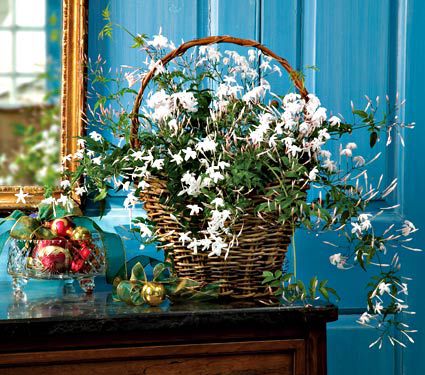






Jasmine: Fragrance Beyond Description in the Dead of Winter
Native to southwest China, Jasminum polyanthum offers a heady perfume—a rich, sweet scent that will fill a house or lightly carry through a southern garden. Its dark leaves provide the perfect backdrop for a late January display of pink buds that open into a mist of exquisitely fragrant white flowers.
This Jasmine was introduced in England in 1931. In the 1950s while on a Christmas visit home to Shropshire, our head gardener came upon a greenhouse full of the exotic vine. Of course he wanted to bring it to Connecticut, so he made about 100 cuttings! As a result, we were among the first to offer this glorious plant for sale in the United States.
How We Grow our Jasmine
We continue to grow Jasmine at the farm, a process that takes months of care before the plants are ready for shipping. In late spring, rooted cuttings are potted in the greenhouse. They grow rapidly—up to 6 inches a day. As the season progresses, we carefully pinch new shoots back to develop strong, bushy plants. The stems for ring topiaries are slowly trained along wire forms. Pinching stops in early fall and the flower buds appear soon thereafter.
We are pleased to offer our Jasmines in several presentations: trained in a ring, paired with Angel Vine topiaries, growing in a hanging pot or in a grapevine basket. In any form, a plant in bloom will put winter temporarily at bay.
How We Ship
We ship our plants with buds already set, so with proper care an explosion of midwinter bloom is assured.
This is a tender plant, so we will begin shipping holiday gift orders in mid-November, weather permitting.
Videos
Jasmine - How to Care for Your Plant
Growing Jasmine: Jasmine is easily grown as a houseplant but will not tolerate dry heat or dry soil. If plants are placed in a cool spot and enjoy bright, indirect light, we guarantee bloom on every plant.
The cultural requirements of Jasminum polyanthum are simple but exacting. When your plant arrives, put it in a cool room—one where the temperature doesn’t climb above 65°F. If exposed to temperatures warmer than 65°F, your plant will grow but not flower.
Light, Water & Humidity: Set it in a window that receives bright light but little or no direct sun. Water only when the top inch of potting mix is dry to the touch; Jasmine won’t tolerate soggy potting mix. If these conditions are met, flowering generally begins in late January or early February.
Jasmines are sensitive to the dryness created by radiators, hot-air vents, and wood-burning stoves. The best way to increase the humidity around your plants is to run a humidifier nearby. You can also set plants in trays filled with pebbles or gravel. Add water to a level just below the tops of the pebbles (if the potting mix in the pots comes in contact with the water, the mix will draw water into the pot, which will cause the mix to become saturated, eventually leading to rot). Refill trays frequently to replace water lost through evaporation. (Our Humiditrays perform the same function without the need for pebbles.)
Cultural Care: After bloom, give your plant at least 6 hours of direct sun daily and normal room temperatures.
When the danger of frost has passed, set the plant outdoors for the summer, shifting it gradually from a shady spot to full sun.
We recommend that you fertilize every 2–4 weeks during the growing season—generally from early spring to early fall—and that you withhold fertilizer entirely during fall and winter, when most plants rest. Use a water-soluble fertilizer designed for houseplants (available on our Web site or at garden centers) mixed at just half the rate suggested by the manufacturer. As with watering, plants suffer if overfertilized. Please note that increasing the amount of fertilizer you use or the frequency with which you apply it is rarely the remedy for an ailing plant. In fact, giving a sick plant more fertilizer may seal its fate. Try to determine the exact cause of the problem (insufficient light? overwatering? air temperature too high? too low?) before you attempt to remedy it.
Prune as necessary to control size or to maintain shape, but stop pruning by August 1, because the plant sets flower buds in late summer.
To encourage the formation of flower buds for next winter, be sure your plant experiences the cooler temperatures and shorter days of early autumn. The plant needs 4–5 weeks of nighttime temperatures between 40° and 50°F, plenty of sunlight, and the complete absence of artificial light after sundown. Bring the plant indoors before frost. Then give it cool temperatures and indirect light until it blooms again in late winter.
White Flower Farm is your dependable source for Jasmine, Jasmine flowers, and Jasmine plants.
Copyright © www.100flowers.win Botanic Garden All Rights Reserved